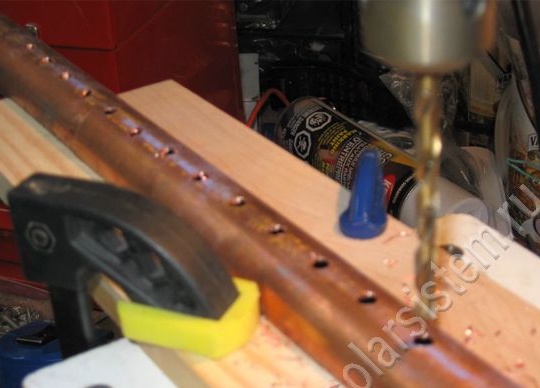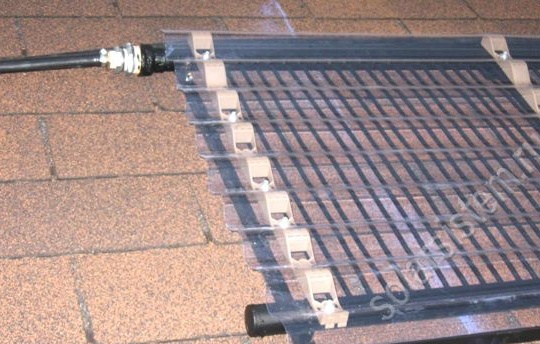
In this project, the author decided to make a solar collector for heating the pool. Since in the summer the roof of the buildings heats up quite a lot, the author decided to use this factor as an element of the casing, absorbent for the construction of his solar collector.
The materials that were used to create this model of the solar collector:
1) copper pipe with a diameter of 1 1/4 "
2) 1/4 "diameter copper pipe
3) gas burner,
4) lead-tin solder
5) flux.
6) core
7) drilling machine
8) transparent slate
Consider in more detail the design of this solar collector.
If the roof on which the collector will be placed is covered with black roofing material or dark bituminous tiles, then it can easily replace the thermal insulation of the back wall of the collector itself. Thus, you will save money and time on the creation of a solar collector.
However, it is still necessary to make a frame for installing a heat exchanger in it. Since high temperatures of the heat exchanger can damage the roof surface, if the heat exchanger is located directly on it. In addition, it will be easier to fix glass in the frame, which will protect the heat exchanger from the wind. The author chose a metal frame as the material for the frame, but it can also be made of wood, anyway it will not heat up as much as the heat exchanger element itself.

The author himself decided to make the heat exchanger from copper pipes used in water supply, heating and air conditioning systems.
To begin with, the author proceeded to marking the main pipes of the future heat exchanger, which will subsequently be interconnected by pipes of smaller diameter. To do this, a center line was drawn along each wide pipe, on which outlines for drilling were made. For marking, the author used a core, and made them every 20-30 mm. This frequency of marks is due to the fact that the collector itself will not have any absorbent other than the roof surface.

After marking, the author proceeded to drilling. The author preferred to drill on the machine, since when using a drill there is a great chance to spoil the pipe, because the holes are very close relative to each other.

Then the author started cutting thin pipes that will connect the main pipes of the collector. It is very important that all tubes are equal in length. After cutting, the ends of each tube should be well protected from oxides. After that, you can begin to install the tubes in the holes intended for them on the surface of the main pipes. It is also important to ensure that the tubes do not go deeper than 1 \ 4-2 \ 3 of the diameter of the large pipe.


To fix the pipes, they must be soldered. To do this, you need to apply a flux to the soldering places, and then fasten the pipes with a torch and solder. To connect water to a heat exchanger, the author made fittings at two ends with a transition to a thread, and closed the other two ends of large pipes. Thus, water will circulate throughout the heat exchanger, which will transfer heat to it.

In order to prevent leaks, the author decided to connect the heat exchanger to the water supply and let the water under pressure. All detected leak points were once again soldered, after which the heat exchanger was again tested.
After completing the tests, the author proceeded to paint work. For this, the surface of the heat exchanger was degreased, after which the heat exchanger itself was painted black.
Then the author proceeded to install the entire system on the roof of the building. After he fixed the heat exchanger frame on the roof, a transparent coating was installed on top, which will serve as protection against the wind. In this case, the author decided to use a transparent slate.
Thoroughly degrease the heat exchanger with a solvent, paint it in black, install it in a frame and mount it on the roof.
On top of the heat exchanger, to the frame, we attach a transparent coating, glass or, as in this case, transparent slate, although ordinary glass can also be used.

As a result, a collector was made, which serves to heat water in the pool. With an air temperature of 21 degrees and an initial temperature of water in the pool of 17 degrees, this system heated 19 cubic meters of pool water to 22 degrees in one day. A similar result is not bad considering the small size of the solar collector itself, which turned out to be 160 cm long and 50 cm wide.
